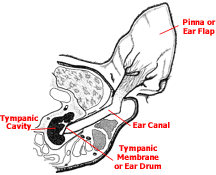Posted on 19 Jan 2015 in Dogs, Disease
Otitis Externa (ear infections) In Dogs

Ear infections are a common problem in dogs. As you can see from the above illustration, dog’s ear canals are long and have a vertical and a horizontal component. Ear infections are not always obvious when looking at the outside of the ears.
Dogs will usually scratch at their ears or shake their heads when they have an infection, and you may detect a smell, or see excess wax or discharge in the ear canal.
If you notice any of these signs, it is important to take your dog in to see your vet. Don’t try putting anything in your pet’s ears (including ear cleaners) until your vet has properly examined them, and advised you on what is safe to use.
Unfortunately ear infections are a recurring problem for some dogs. The following information is intended to give you an understanding of why ear infections occur, and the best way to treat them.
What factors predispose dogs to ear infections?
There are a number of factors that can predispose a dog to ear infections. These factors alter the environment in the ear canal, making it more likely to become infected. Common predisposing factors in dogs include:
1.The conformation of the ear canals, such as narrowed ear canals, the presence of hair, or an abundance of secretory glands. Certain breeds are more prone to ear problems due to their conformation.
2.Moisture can predispose dogs to ear infections. Increased humidity or swimming can result in increased moisture in the ear canals and maceration of the ear canal, resulting in infection.
3.Trauma from excessive cleaning with ear cleaners or cotton buds, or vigorous hair plucking can also predispose to infection.
What primary factors can cause ear problems?
There are also primary factors that can directly cause inflammation of the ears (otitis externa). The most common primary factors include:
1.Parasites – ear mites are one of the most common parasites which affect the ears, sometimes they can be seen when your vet examines the ear with an otoscope, but other times we can only identify them by looking under a microscope. Fleas and ticks are other common parasites which can cause ear problems.
2.Allergies – Atopy is the most common underlying disease in recurring or chronic ear infections. Atopy is a genetically predisposed condition, where inflamed, itchy skin (including the skin lining the ears!) develops in response to environmental allergens. Dysfunction of the skin barrier is thought to play a role in this process. Dogs can react to many different allergens and if atopy is suspected further investigation and treatment is required. Food allergies can also commonly result in recurrent otitis externa, and a food trial is recommended.
3.Foreign bodies – eg. Grass seeds, dirt, sand, hair can induce irritation.
What factors perpetuate ear problems?
Infection of the ear with an overgrowth of bacteria or yeasts (or both) then develops as a result of these predisposing and/or primary factors. It isn’t long before the pet is seen scratching at his ears, shaking his head or holding his head to one side. Discharge and odour may be noticeable to people. Bacteria and yeast infections must be treated medically.
Treatment of ear infections
Ear infections can be a frustrating, recurring problem, and it is important to treat them properly from the start. To do this we need to know what sort of infection is in the ear, to do proper home care regularly, and to have recheck appointments to ensure that infections have resolved before stopping treatment. In recurrent cases preventative measures are then put in place to help prevent recurrence.
1)The first step is to work out whether bacteria or yeasts are involved (or both), and the type of bacteria present (cocci or rods). This will help us determine the most appropriate ear drop for your dog. To do this we take a sample of the discharge from your dog’s ears and examine it under the microscope. In some cases (rod infections) we can need to send a sample away to be cultured to determine which treatment to use, as resistance to multiple antibiotics is common with these infections.
2)It is important that we thoroughly examine the ear canals and try to assess whether the ear drum is intact (if the ear drum is ruptured, some treatments will not be safe to use). It is also very important to thoroughly clean the ear canals, as discharge in the ears will prevent medication from working effectively. In the majority of cases an ear cleaner can be used at home. However, as ear infections can be very painful, a general anaesthetic may be necessary to properly assess and clean the ear canals, and this can be an important part of the treatment process.
3)Once the ear canals are clean, and we have determined the type of bacteria/yeast present, we can start on an appropriate ear drop to resolve the infection. Different sized dogs have very different sized ear canals and your vet will advise you on the volume of ear drop required. A course of corticosteroid tablets (prednisolone) is often required to help reduce the inflammation. In severe cases we will also need to use oral antibiotics for a minimum of 3-4 weeks.
4)Revisit appointments are essential to monitor the response to treatment, these are usually performed weekly. We need to look into the ear canals with an otoscope to assess the degree of inflammation and discharge in the canal, and we need to repeat the cytology (looking at the discharge under a microscope) to assess whether the infection is resolving. It is very important to treat the ears until we do not see any bacteria or yeast on cytology (and usually for 1 week after this). For mild cases that respond quickly to treatment 10-14 days of treatment may be required, in more severe cases at least 3-4 weeks of treatment is needed. If we do not treat the ears for long enough, we are likely to get recurrence of the problem, and future treatment can be more difficult.
Helping prevent recurrence
1)Address underlying causes such as allergies
2)If the ear infection is likely to have occurred due to moisture in the ear canals we may recommend a drying agent be used 1-3 times a week to help prevent recurrence.
3)We may also recommend the use of an ear cleaner every 1-2 weeks to help prevent recurrence.
4)For allergic dogs with recurring problems (but no infection) we may prescribe an ear cleaner with a cortisone anti-inflammatory added to it to use on a regular basis to help prevent recurrence.
Complications of Ear Infection
Middle ear infection (otitis media) - If the infection reaches the middle ear, affected animals may have a head tilt, a lack of balance, and unusual back-and-forth eye movements called nystagmus. These symptoms are called vestibular signs and can indicate a complication of middle ear infection. Aggressive treatment is required in these cases.
Ears that don’t respond to medical treatment – In some cases as a result of chronic ear infections the ear canal becomes so scarred that it is practically closed, and ablation may be the final option. In this specialist surgical procedure, the entire ear canal is removed and healthy tissue is allowed to grow in. These procedures are last resorts after severe infection has made effective medical treatment impossible.


